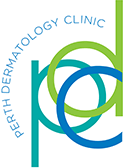Topical Steroids are the mainstay of eczema/dermatitis management.
They are safe and very effective when used appropriately as instructed by your Dermatologist at Perth Dermatology Clinic.
They work by reducing inflammation and helping to control an over-reactive response of your immune system at the location of your eczema in the skin.
There are many different types and strengths of topical steroids. They may be applied once or twice a day to the affected areas of eczema. This should be continued until the eczema is cleared and may then be tapered off as instructed by your dermatologist. Enough cream should be used to cover the entire affected area and then rubbed or massaged in. Moisturisers may be applied 5-10 minutes after this to the whole skin.
There are many misconceptions and myths regarding topical steroids. There is no need to ‘use sparingly’. This instruction often leads to under treatment and chronic eczema. Topical steroids can be used on broken skin – if skin infection is suspected also, a swab and appropriate treatment may concurrently be recommended by your dermatologist to use whilst applying topical steroids. The safety profile of topical steroids when used appropriately is excellent. Inappropriate use (ie not as directed by your doctor) can lead to side-effects. These side effects are discussed below:
Side Effect Guide for Appropriate Topical Steroid Use:
- Peri-Orificial Dermatitis – can occur from long term inappropriate use of topical steroids on the face.
- Skin thinning/Atrophy – skin thinning is rare, and irreversible skin thinning does not occur.
- Stretch Marks/Striae – occur from inappropriate use of strong topical steroids in sensitive sites such as the armpits and groin.
- Broken Capillaries/Telangiectasia – this is rare and does not occur with appropriate use.
- White or Brown Discolouration – this is called post inflammatory hypopigmentation (white) or hyperpigmentation (brown) that may occur at the sites of eczema cleared with the application of topical steroids. It is not caused by the topical steroid, but rather the eczema itself. This will return to normal once the skin repairs itself after several weeks-months.
- Cataracts and Glaucoma – this is a rare side effect and careful, short-term and supervised use when applying topical steroid to the eyelids is recommended.
- Allergy – Allergic contact dermatitis is rare and should be suspected in those with eczema not responding to topical steroids.
- Topical Steroid Resistance – this is called tachyphylaxis and implies that the skin has become resistant and no longer responds to topical steroid after repeated use. There is no definitive evidence to support this.
- Reduction in the Body’s ability to Produce Its Own Steroid – This is known as hypothalamic-pituitary-adrenal axis suppression and only occurs in the most extreme circumstances of inappropriate topical steroid use whereby high strength steroids are applied to the majority of the skin under occlusion for prolonged periods without supervision.
Your dermatologist at Perth Dermatology Clinic will empower you to use topical steroids appropriately and safely for your eczema/dermatitis with practical advice and accurate information.




